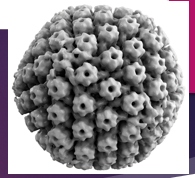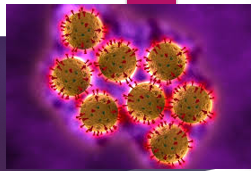Viral Diseases in humans
1/72
Earn XP
Description and Tags
Name | Mastery | Learn | Test | Matching | Spaced |
|---|
No study sessions yet.
73 Terms
Herpes simplex virus (HSV) types
HSV-1: oral herpes
HSV-2: genital herpes
herpes simplex virus structure
double stranded DNA virus in the Herpesviridae family
icosahedral capsid surrounded by a lipid envelope

herpes simplex virus latency
after initial infection, HSV enters latent phase in neurons
remains dormant for long periods of time and can reactivate later, causing recurrent symptoms
HPS transmission
spreads through direct contact with infected bodily fluids, skin, or mucous membranes, even when symptoms aren’t present
HVS lifelong infection
causes a lifelong infection because of its ability to evade immune system and persist in a latent state
HSV symptoms
painful blisters or sores
fever
malaise
HSV diagnosis
can be diagnosed using PCR, viral culture, or serology
HSV treatment
antiviral medication such as acyclovir, valacyclovir, or famciclovir can help reduce symptoms and frequency of outbreaks but does not cure infection
HSV prevention
safe sec practices
avoiding contact during outbreak
smallpox causative agent
caused by the variola virus (Poxviridae family)
large, double stranded DNA virus
smallpox eradication
officially eradicated in 1980
first and only human disease to be eradicated
smallpox transmission
spreads through respiratory droplets, direct contact with infected bodily fluids, or contaminated objects
highly contagious
smallpox symptoms
presents with fever and malaise, followed by a progressive rash that turns into pustules, mainly affecting the face, arms, and legs
smallpox incubation period
ranges from 7-17 days
person infected is asymptomatic
smallpox vaccine
originally made from a related virus (vaccinia virus)
crucial in eradication efforts
provides long term immunity
smallpox bioterrorism concern
stocks of the virus are held in high-security laboratories
smallpox diagnosis
before eradication, diagnosis was based off clinical symptoms and confirmed through electron microscopy and viral culture
influenza family
part of the Orthomyxoviridae family
envelope, single-stranded RNA virus
influenza subtypes
subtypes of 2 surface glycoproteins
hemagglutinin (H)
neuraminidase (N)
influenza antigenic drift
small, gradual mutations in the virus’s RNA led to seasonal flu
influenza antigenic shift
major genetic charge, often from reassortment of viral genome segments can result in new influenza A subtypes, leading to pandemics
influenza host
humans
birds
pigs
influenza transmission
spreads via respiratory droplets, direct or contact with contaminated surface
influenza symptoms
fever
cough
sore throat
muscle aches
fatigues
sometimes gastrointestinal symptoms
influenza epidemics and pandemics
typically responsible for seasonal flu outbreaks
influenza vaccinations
annual flu vaccines are developed to target most likely circulating strains
influenza antiviral treatment
drugs like oseltamivir (Tamiflu) zanamivir (Relenza) and baloxavir
influenza diagnosis
rapid diagnosis test, RT-PCR, or viral culture
influenza public health impact
influenza A is a significant public health concern due to its potential for rapid spread, high mutation rates, and potential for causing severing
Ebola Hemorrhagic fever causative agent
caused by Ebola virus
member of filoviridae family
enveloped, single-stranded RNA virus
Ebola natural reservoir
believed to be fruit bats
other animals like non-human primates can also become infected with the Ebola virus
Ebola transmission
transmitted through direct contact with blood, body fluids (vomit, urine, sweat) or tissues of infected individuals or animals
Ebola symptoms
starts with flu-like symptoms
progresses to severer gastrointestinal symptoms, organ failure, and potentially death
Ebola’s high mortality rate
25-90%
Ebola pathophysiology
targets and damages the endothelial cells, immune cells, and liver, leading to
Ebola incubation period
2-21 days after exposure
Ebola diagnosis
can be confirmed through RT-PCR, ELISA, viral isolation
Ebola treatment
no specific cure for Ebola
supportive care is critical
antiviral drugs (remdesivir) and monoclonal antibodies
Ebola vaccine
rVSV-ZBOV vaccine was approved and has been used to control outbreaks
Ebola public health concern
still a significant global health threat due to its potential for large outbreaks
SARS virus causative agent
Severe Acute Respiratory Syndrome
caused by SARS-CoV (SARS-associated coronavirus)
enveloped, single-stranded RNA virus in the Coronaviridae family

SARS origin
believed to be bats with civets as an intermediate host
first identified in 2002-2003 outbreak in Guangdong, China
SARS transmission
respiratory droplets
SARS symptoms
presents with flu-like symptoms
can progress to dry cough, shortness of breath
in severe cases, patients develop acute respiratory distress syndrome
SARS incubation period
2-10 days, average of 4-6 days
SARS epidemiology
over 8000 cases
774 deaths
SARS receptor binding
virus attaches to ACE2 (angiotensin-converting enzyme 2) receptors on host cells on lungs and GI tract
SARS diagnosis
RT-PCR
SARS treatment
no specific antiviral treatment
oxygen therapy, fluids, and mechanical ventilation in severe cases
some antiviral agents and corticosteroids were used experimentally during the outbreak
SARS prevention and control
quarantine, travel restrictions, and isolation of individuals
rotavirus causative agent
double-stranded RNA virus from Reoviridae family
wheel-like appearance

rotavirus structure
icosahedral, triple layered capsid
rotavirus epidemiology
leading cause of severe gastroenteritis in infants and young children worldwide
responsible for hundreds of thousands of child deaths
rotavirus transmission
fecal-oral route
rotavirus symptoms
severe diarrhea, vomiting, fever, abdominal pain, which leads to dehydration
can be life threatening to young children
rotavirus incubation period
1-3 days
rotavirus diagnosis
diagnosed through ELISA, latex agglutination, or PCR
rotavirus vaccine
oral vaccine
rotavirus prevention
proper hygiene
handwashing
ensuring access to clean water and sanitation
rotavirus treatment
no antiviral treatment for rotavirus
treatment focuses on oral rehydration therapy along with intravenous fluids
rotavirus pathophysiology
infects and damages epithelial cells of small intestine, which leads to malabsorption and fluid loss
also produces viral enterotoxins, like NSP4
rotavirus global disease burden
still continues to cause around 200,000 child deaths annually where access to vaccines and healthcare is limited
HIV causative agent
retrovirus from the Lentivirus genus in the Retroviridae family
single-stranded RNA that is reverse transcribed into DNA within host cells
HIV structure
enveloped virus with a conical capsid
genome encodes important structural and enzymatic proteins like reverse transcriptase, protease, integrase, and envelope proteins (gp120 and gp41)
HIV target cells
targets CD4+ using the CD4 receptor and co-receptors and co-receptors (CCR5 or CXCR4)
HIV transmission
contact with infected blood, semen, vaginal fluids, rectal fluids, and breast mil
HIV replication cycle
reverse transcribes its RNA into DNA, which integrates into host genome
stages of HIV infection
acute HIV infection
occurs 2-4 weeks after exposure with flu-like symptoms
clinical latency (chronic HIV)
virus remains active but reproduces at low levels
AIDS (acquired immunodeficiency syndrome)
HIV severely weakens the immune system, leading to opportunistic infections
CD4+ cell count drops below 200 cells/ul
HIV diagnosis
diagnosed using serological tests or PCR
HIV treatment antiretroviral therapy
main treatment for HIV
combination of drugs that target different stages of HIV life cycle
cannot cure HIV but can reduce viral load to undetectable levels
HIV opportunistic infections
weakened individuals can be vulnerable to other infections such as tuberculosis, pneumocystis, pneumonia, toxoplasmosis, and Kaposi’s sarcoma
HIV global impact
approximately 38 million people living with HIV as of 2021
HIV research and vaccines
no cure or vaccine